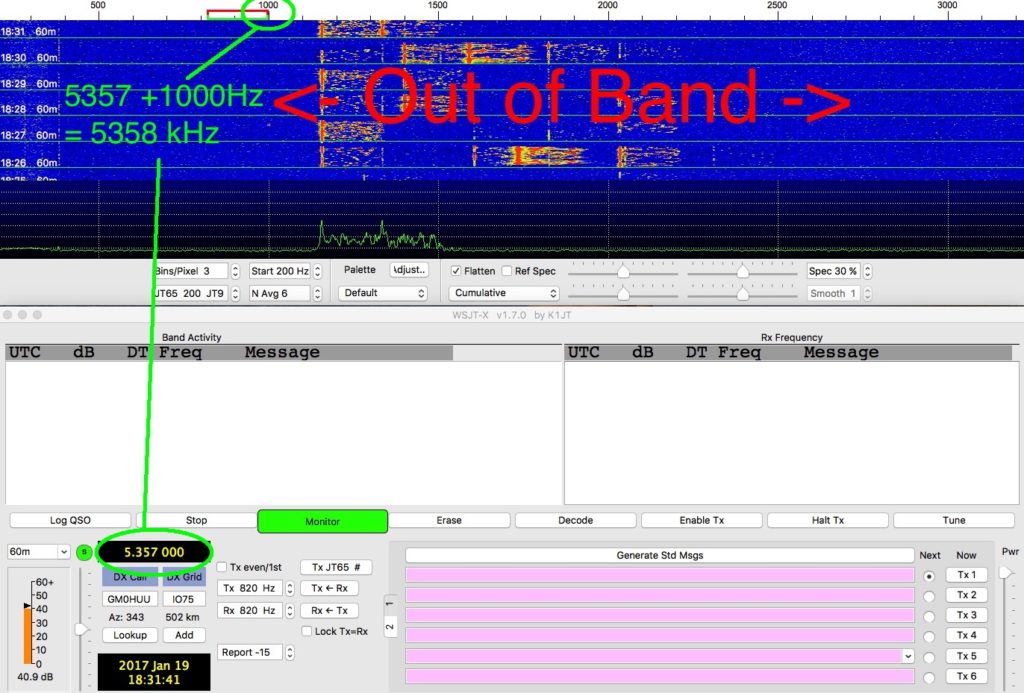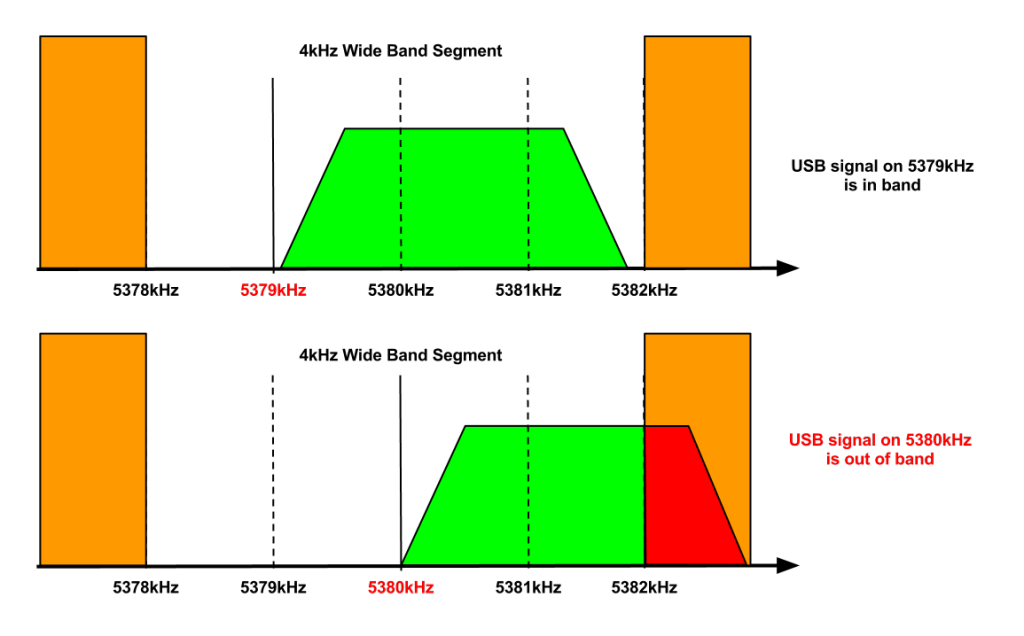5MHz
Frequencies at 5MHz are available on a secondary basis to holders of a UK Full Amateur Licence. The maximum permitted output power is 100 Watts from the transmitter and 200 Watts eirp from the antenna. Mobile operation is not allowed.
UK 5MHz Frequencies
The 5351.5 – 5366.5kHz WRC-15 allocation is not in effect in the UK, so stations must adhere to the frequencies set out in the licence schedule.

UK Operation
This largely follows the conventions shown here but exceptions are common and QSOs on popular frequencies may be found using any mode. Take care not to transmit outside the UK segments even if amateur signals can be heard as they may be coming from other countries with different allocations.
| Lower limit kHz | Upper limit kHz | Guidelines on current usage and suggested USB frequencies |
| 5258.5 | 5264.0 | CW activity, 5262kHz QRP |
| 5276.0 | 5284.0 | USB 5278.5kHz, EMCOMM CoA |
| 5288.5 | 5292.0 | Beacons 5290kHz |
| 5298.0 | 5307.0 | All modes. USB 5298.5kHz, 5301kHz, 5304kHz |
| 5313.0 | 5323.0 | All modes. AM 5317kHz. USB 5320kHz |
| 5333.0 | 5338.0 | USB 5335kHz |
| 5354.0 | 5358.0 | All modes. USB 5354kHz. In WRC-15 band |
| 5362.0 | 5374.5 | All modes. USB 5363kHz, 5371.5kHz. WRC-15 band to 5366.5kHz. Weak signal 5366.0 – 5366.5kHz |
| 5378.0 | 5382.0 | USB 5379kHz |
| 5395.0 | 5401.5 | USB 5395kHz, 5398.5kHz |
| 5403.5 | 5406.5 | USB 5403.5kHz |
Please do not transmit out-of-band. Selecting a USB frequency from the table above will ensure compliance and is largely compatible with allocations in other countries also.
Please do not transmit USB on 5330.5kHz, 5357kHz, or 5360kHz. Also do not transmit CW between 5351.5 – 5354kHz. These frequencies are commonly used in other countries but are outside the UK allocation.
Notes on the frequency table:
1. The current UK allocation only covers parts of the 5351.5 – 5366.5kHz band. For UK QSOs, try to avoid the busy WRC-15 segment, shown in green above, and leave it available for international contacts or stations with no other option. The USB frequencies indicated are either spot allocations in other countries or are at least 3kHz away from them to avoid interference. For example, 5354kHz avoids interference to 5357kHz, and 5335kHz avoids interference to 5330.5kHz, both of which are common to many countries but cannot be used in the UK.
2. A band plan for the 5351.5 – 5366.5 WRC-15 allocation was agreed at the IARU Region 1 Meeting in September 2017. The USB frequencies 5354kHz and 5363kHz shown in the table above are within the all modes segment of the WRC-15 band. The proposed weak signal segment for <20Hz narrow band modes from 5366.0 – 5366.5kHz also falls within the UK 5MHz frequency schedule. The segments of the IARU band plan in red below cannot be used in the UK.
| kHz | 5351.5 5354.0 | 5354.0 5358.0 | 5358.0 5362.0 | 5362.0 5366.0 | 5366.0 5366.5 |
|---|---|---|---|---|---|
| Modes | CW [Red] | All modes [Orange] | All modes [Red] | All modes [Orange] | Weak Signal [Yellow] |
3. Upper sideband is recommended for SSB operation at 5MHz to preserve compatibility with other services. USB frequencies are suppressed carrier frequency.
4. Ensure that the transmitted spectrum is completely within the allocated frequencies. The transmitted spectrum of an upper sideband signal extends from the suppressed carrier frequency, usually also the indicated or dial frequency, to 3kHz higher, so set the frequency at least 3kHz below the top of the band segment. As an example in the diagram below, the narrow segment of 5378 – 5382kHz is only wide enough for one SSB signal which should be no higher than 5379kHz for the signal to remain within the allocation:
Similarly, with digital modes on 5357kHz, any transmission greater than 1000Hz (1kHz) on the waterfall will be above 5358.0kHz and therefore out of band, see diagram below:

5. AM operation is permitted provided the maximum bandwidth does not exceed 6kHz. AM activity can often be found on 5317kHz.
6. Frequencies between 5366.5kHz and 5371.5kHz are recommended for digital mode activity within the UK.
7. Note that the segment from 5403.5 – 5406.5kHz is only 3kHz wide. For USB, set the radio to 5403.5kHz as any other frequency would result in the transmitted spectrum being out of band.
8. Beacons operate around 5290kHz. It would be helpful if operators do not transmit in this narrow segment. Since the release of the WRC-15 band, WSPR activity has moved to the weak signal segment between 5366.0 – 5366.5kHz.
9. As with the WARC bands at 10, 18, and 24MHz, there should be no contest activity on 5MHz.
Communications with Military Cadet Stations
Communication with UK military cadet stations is permitted. These stations will identify with callsigns of a different format to amateur calls and they use a concise operating procedure. They are unlikely to give operator names or locations but will often exchange information on equipment and aerials. Whilst military stations may be heard on any frequency around 5MHz, amateur stations must never attempt to contact military stations outside the frequency allocations above.
The 5MHz Newsletter
Paul G4MWO produces a regular newsletter on 5MHz activity and operation around the world, which also gives useful information about the current status of 5MHz. It can be downloaded or read as a pdf file in a new tab here. The 5MHz Newsletter archive is here.
RSGB 5MHz Experiment
Since gaining permission in 2002 to experiment on 5MHz, the Society has provided a basic propagation experiment in which UK amateurs could participate. This experiment is now concluded and we would like to thank everyone who participated. Activity on 5MHz over the last 10 years or more from the UK greatly helped the amateur service gain a 5MHz allocation at WRC-15.











